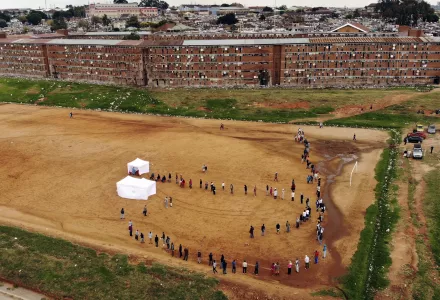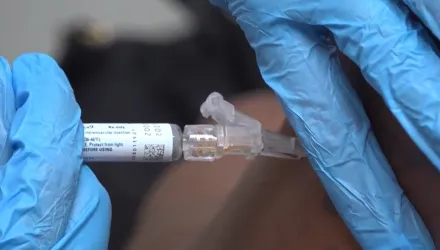
From the rise of a pandemic to the collapse of national economies, the time we are living in is unprecedented. More than three million people to-date have been infected by coronavirus, and over 210,000 people worldwide have lost their lives.1 National governments have been forced to test strategies for increased clinical capacity, crisis welfare, and public restrictions to “flatten the curve.” With social distancing taking hold across the United States and the world, we are starting to look for the light at the end of the tunnel – hoping that things can one day go back to some version of “normal.” But the reality is that this pandemic, the economic downturn, and our choices during response will have lasting impacts, making almost certain that our future will be quite different from our past. And while the immediate concern is that of limiting fatalities and ensuring that our health system can survive a surge of cases, pandemic technologies—diagnostics, therapeutics, and vaccines—will shape the next phase of crisis response. This is a phase where we not only prevent the spread, but also build public resilience.
While some may argue that rapid biomedical development is our best option to fight the spread and build resilience against coronavirus, releasing undertested technologies, such as antibody tests or new vaccine candidates, may generate more overall harm to the public in the longer run - outweighing any sense of relief they seemingly provide in the short term. Historic examples, like a relaxation of the FDA drug approval process during the HIV/AIDs crisis in the 80s demonstrates the cascading effects of deteriorated oversight: many of the drugs that passed the lowered FDA standards had severe and permanent side effects that are still, decades later, being felt.2, 3 Even the experimentation of drugs, if not thoughtful, can yield widespread consequences, such as the case of Thalidomide in the 50s, where over 10,000 doctors across the U.S. tested a sleep medication drug on pregnant women despite reports of severe side effects when used on patients in other countries.4 This experimentation led to crippling deformities in the newborns of women who took the drug; in many cases, babies died in the womb.
We must remember, this time is not any different. In fact, we are already hearing about the intense side effects from using the experimental COVID-19 drug chloroquine to treat patients, such as erratic heartbeats, vertigo, muscle weakness, and even death in some cases.5 The urgency of the current pandemic cannot eclipse the real ethical considerations that surround biomedical innovation, especially because the choices we make now will have both immediate and long-term implications. We must weigh the opportunities with the risks.
The issues that we must consider in the development of diagnostics, therapeutics, and vaccines involve (but are not limited to):
- Efficacy: Do these technologies work?
- Scalability: Can we make and use them in large quantities?
- Accessibility: How do we decide who gets access? And at what cost?
- Research ethics: Should we test things in humans that have not been tested yet through other standard means?
- Risk communication: How do we meaningfully communicate to consumers about the uncertainty of results and foreseeable risks?
For each class of technology, these issues appear in different forms. At a fundamental level, our research and governance structure, such as FDA research standards and drug approval processes, is designed to address these questions. However, this work normally occurs over several years, not over the timescale of several months that has become anticipated for coronavirus, and it is often not under the same level of public pressure to yield such quick results. This raises the issue of how we assess public purpose—safeguards to protect the general interest and values of our society, such as privacy, safety, security, equity, and inclusion—during the expedited scheme of pandemic response.
In this piece, we will look at the various public purpose considerations as they relate to the development of diagnostics, therapeutics, and vaccines for coronavirus. We explore the foreseeable risks to public safety of loosened regulation, ultimately arguing that even in times of crisis, accountable science and technology development is a choice we can make to protect the public and yield beneficial results, while considering both short- and long-term impacts.
The Diagnostic Debacle
The story of COVID-19 will inevitably include a chapter about the U.S.’s failure to rapidly develop diagnostics and deploy them effectively: how the U.S. chose not to use the diagnostic kit recommended by the WHO; how the first set of CDC’s distributed test kits were faulty; and, ultimately, how the nation lagged behind in its ability to trace and control the virus due to an undersupply of testing weeks into the pandemic. As we attempt to exponentially expand testing now though, we must focus some attention on the next questions regarding efficacy, scalability, and accessibility: how can we ensure that these tests work, their production is indeed scalable, and there is a clear plan for distribution and use?
The initial declaration of a public health emergency and activation of the Emergency Use Authorization (EUA) essentially restricted tests to the “CDC test,” hampered development of local laboratory testing capacity, and delayed development of new diagnostics.6 To overcome the lack of supply as the number of cases grew, the FDA dramatically loosened regulations for test approval—allowing tests to be used even before they are approved by the FDA – essentially undermining the purpose of the EUA. Going further, the FDA delegated, rather than keeping centralized, various testing approval responsibilities to states. This was, in the words of the FDA, a historic deregulation of the diagnostic approval process—though arguably a necessary one given the complete paucity of testing in the United States.
The explosion in diagnostic development that these moves enabled created a wave of sub-standard testing options, such as COVID home tests. Eventually, being too big to ignore, the FDA intervened to stop certain low-quality tests from being used.7, 8 But it is not only at-home tests that must be subject to scrutiny. Point-of-care tests, or tests that can be run in your doctor’s office without being sent to a lab, also raise concerns. Rapid approval of the Abbott ID NOW system for COVID-19 testing aimed to expand access to testing (though, it is important to note that this expansion has yet to materialize) by providing a portable high-quality rapid test. However, subsequent analysis of the system found that the test, when performed based on the protocol approved by the FDA, resulted in numerous false negatives.9 False negatives in an infectious disease setting can be particularly harmful by increasing the chance that someone who is infected will unwittingly spread the virus, or fail to get access to needed care.10 FDA’s loosened oversight is an attempt to reduce barriers for the fast production of much needed testing kits, but without oversight, we risk compromising quality for quantity—and this could have severe negative implications for response efforts.
As effective point-of-care diagnostics as well as rapid and high-throughput diagnostics become more widely available, we will hopefully be able to reduce time to diagnosis and isolate those infected with the virus. This will prevent situations where there is a harmful delay in preventing spread, like with the healthcare professional in New Hampshire who attended a social gathering while awaiting his test results,11 or with the man from New York that took a flight while his diagnostic results were pending.12 While the U.S. government funded a program to distribute point-of-care systems, they not specifically targeted to the most impacted areas. This begs the question of whether the government should acknowledge diagnostic platforms as a critical element of our public health infrastructure, and assist hospitals in having the latest devices. Or should it be each hospital for their own?
New diagnostics that are not the traditionally used assays must be developed. Companies, such as Sherlock Biosciences and Mammoth Biosciences, and various research groups are developing tests using CRISPR technology13 to detect the virus. A preliminary test developed, but not currently approved by Mammoth, demonstrated the ability to detect the coronavirus with a readout similar to a pregnancy test.14 However, neither of these companies have commercially available tests approved by the FDA to date. Until these diagnostics become approved, their absence in the market will inevitably continue to raise questions about both their efficacy, as well as whether these companies can scale the distribution of their technology.
Alternate approaches focus on developing rapid tests that detect antibodies to coronavirus. These tests could potentially be used to determine who had or is immune to the virus. But while these tests are likely to be able to detect antibodies against the virus, more thorough research needs to be conducted to confirm that the presence of antibodies positively correlates with immunity and protection. Antibodies isolated from patients can and are being tested rapidly to see if they are protective against the virus – and evidence suggests that they may be—as would be expected from our understanding of immunity. Access to these tests will be critical to determining who was infected, is now likely protected from reinfection, and by extension, is able to return to work due to this immunity. Much like other diagnostic tools though, there is the risk of inaccurate results from antibody tests: reports suggested that some tests currently marketed may confuse SARS-CoV-2 (the virus that causes COVID-19) with another coronavirus that causes the common cold.15 The Association of State Public Health Labs went as far as to call some of the tests that are being marketed without FDA approval “crappy”.16 And beyond efficacy, we need to be able to scale these tests in order for them to prove effective in as a response tool.
In an effort to consider public safety, security and accessibility, we must also consider what public purpose means during a pandemic. What threshold of “good enough” are we willing to settle on for the diagnostics kits we roll out? How important is it that we communicate uncertainty and risks of false positive or negatives to the public? How can we scale the production of diagnostics in a way that is valuable for response efforts? And how do we consider a “fair” distribution of tests?
The Race for Therapeutics
Following diagnostics, one of the immediate medical challenge is understanding how to actually treat those who have coronavirus. Due to scientific reasons and financial constraints, there is a scarcity of antiviral therapeutics, which are treatments that restrict the virus from infecting or growing in cells, particularly for acute RNA viruses such as COVID-19.17, 18 And in the case of a lack of therapeutics, the clinical approach becomes one that opts to manage the symptoms of the virus and provide supportive care, not treat the virus itself. Managing these symptomssuch as acute respiratory distress, requires hospital beds and, in some cases, ventilators and other critical care equipment. Since the U.S. healthcare system does not have an abundance of critical care resources, there is an inherent limit to the number of patients that can be treated through these means. Moreover, if the viral infection continues to grow, even the greatest supportive care can fail. The need for antiviral therapeutics, which would prevent the virus from replicating and spreading, has led to the testing of experimental drugs, such as the anti-Ebola drug remdesivir, that preclinical research has shown could prevent coronavirus from advancing in the body, and other existing medications that are more questionable as effective treatments such as chloroquine and hydroxychloroquine.19
The benefit of using existing medications is that they are approved for use in humans, the production lines already exist, and they can be made widely available. However, the use of some of these medications, such as chloroquine, raises serious questions about efficacy because, ultimately, we do not know whether they work. For example, the French study that concluded hydroxychloroquine can fight the virus had significant flaws.20 The study followed very few individuals and chose to exclude one patient that died and three that were moved to critical care because the researchers could not collect samples after the drug was administered.21 Simply put, one death and three ICU admissions were not considered treatment failures because a nasal swab could not be collected when the study ended. It should be noted that this study, which provided some of the justification for the use and evaluation of chloroquine and hydroxychloroquine as a treatment for COVID-19, was ultimately not published for failing to ascribe to the standards of the journal it was submitted to.
Despite these flaws (and there are many beyond this example), President Trump touted chloroquine as a cure for coronavirus and claimed that the FDA approved its use. Already there are reports of hydroxychloroquine shortages in pharmacies. A man died after trying to take chloroquine without medical supervision or a prescription. Though of course there is a potential for these drugs to work, rigorous testing is necessary to ensure that they do – and this remains an open question, even as medical facilities and potential coronavirus patients buy up stock. And beyond the question of efficacy, it is important to note that these drugs can have side effects. With that in mind, do those side effects warrant use then, especially in mild cases?
Clinical trials can occur quickly, but to protect the public wellbeing and ensure these therapies are more beneficial than they are harmful, they must occur with a meaningful level of robustness. Crowdsourcing clinical trials, as the White House seeks to do, does not meet this level. Therapeutic efficacy, in many clinical trials, is predominantly judged by comparing patients that received the therapeutic to those that did not in a controlled manner – a “randomized placebo-controlled trial”. That means characteristics such as age, gender, race, and preexisting health conditions are balanced in both arms of the trial. This is crucial because these factors impact COVID-19 clinical outcomes. One could imagine that, in a crowdsourced trial where only the sickest receive a therapeutic under compassionate use, that efficacy in patients with a milder infection could be lost. Conversely, without a control arm, a therapy could look like it is doing something based on comparisons to the broader population, but then be found to not actually work after a proper study occurs.
The recent study of compassionate use of remdesivir provides a model for communicating the efficacy of a potential therapeutic before a full clinical trial can be conducted. While the authors noted the positive results, they concluded that “measurement of efficacy will require ongoing randomized, placebo-controlled trials.”22 And this emphasizes the main questions around therapeutic development currently: how can we guarantee the technology’s efficacy? And if we cannot, how to we appropriately communicate that publicly?
A Tale of Three Vaccines
The first reports of atypical and potentially viral pneumonia in Wuhan, China triggered the race for a vaccine. After the coronavirus’ genetic code was published, Inovio Pharmaceuticals announced that they designed a vaccine candidate in three hours.23 Moderna, in collaboration with the National Institute of Allergy and Infectious Disease (NIAID), finalized the design for their vaccine candidate and announced a plan to initiate a clinical trial in two days.24 A Canadian company, Medicago, announced that they produced a “viable vaccine candidate” two months after the virus was identified.25 All supported by government funding to accelerate their development, these timelines for their vaccine generation are extraordinarily fast. As a comparison, research began on the vaccine tested during the 2014-15 Ebola epidemic in the 1990s and it was only clinically approved in 2019, four years after clinical trials began.
The Moderna vaccine candidate reached clinical trial first, with a patient in Seattle receiving it on March 16, 2020—only 63 days following the first release of the SARS-CoV-2 genome sequence.26 This vaccine candidate is unique in that it is one of the first vaccines to go be used on patients without the availability of accompanying preclinical data. Due to time-sensitivity with the pandemic, NIAID announced that preclinical testing will occur in parallel with the early-stage clinical trial—but this still represents a significant departure from the standard, more robust process for vaccine candidates. And while other Moderna products, including a similar vaccine against a different coronavirus, demonstrated the ability to produce a response through standard preclinical and clinical trials, the one for specifically COVID-19 never has. This poses common, but dynamic, questions of research ethics: Is it acceptable to test a vaccine candidate in humans before it has gone through preclinical testing? How is uncertainty communicated to patients? How do we consider the vulnerability of patients in testing ethics?
Additionally, each of these vaccine candidates faces a question of scalability. Reports of Moderna’s production capability suggest that they will be able to produce 100 million doses of their vaccine a year.27 Medicago claims 10 million doses a month.28 Inovio currently reports much smaller capability for production.29 In a circumstance where a poorly produced drug can be deadly, how do we decide whether or not to scale up production of a vaccine before we know if that vaccine even works?
And as it goes, the issue of scalability raises questions of access: If vaccine production is inherently limited, how do we determine who gets a vaccine first? Should the vaccine be made accessible to health workers because of their high exposure? Or should vulnerable populations with the highest mortality rates, such as elderly people, and those with preexisting condition, get priority? And even within vulnerable populations, how can we determine priority?
Moderna already reported that their vaccine candidate, if early clinical trial data is positive, could be made accessible to health care workers in the fall on an emergency basis.30 So, where do vulnerable populations fit in? And if these vaccines are developed with significant government support then who, if anyone, should profit?
As clinical trials for these vaccines advance, we must also consider the importance of domestic equity. A major equity concern rests around pregnant women and their access to a vaccine.31 Often, preclinical studies for reproductive and developmental toxicity are performed after a vaccine is approved or late in development; thus, preventing data on whether it is safe for pregnant women to receive the vaccine from existing during the time that it is most needed. Moreover, the need for speed does not eliminate the need for ensuring that traditionally underrepresented groups, including racial minorities, are able to take part in all COVID-19 clinical trials. As the FDA itself notes, “people of different ages, races, and ethnicities, may react differently to medical products.”
Scientists, technologists, funding groups, and regulators can address concerns about equity through thoughtful preclinical study design, and funding projects that address these concerns. Policymakers, however, will need to focus on the most significant equity question: who will have access to inherently limited therapeutics and vaccines? In a world of nearly eight billion people, what production tools are politicians willing to put in place today to allow rapid scaling of a vaccine candidate? Should there be a trigger that allows the government to partner with any group that demonstrates positive phase I data? And what about preclinical data?
Maintaining Accountability During a Pandemic
When working on pandemic time, there is an inherent pressure to move at pandemic speed, and understandably so—to save lives, stop the spread of the virus, and ease public unrest. But, as we have seen, there is a tradeoff that happens when we expedite—or in many cases, eliminate—oversight processes that aim to act as the guarantor of safe and effective health products. In an effort to ensure public safety and build resilience for coronavirus, we must try to maintain consideration for important issues like efficacy, scalability, accessibility, research ethics, and risk communication.
The recent decision of the FDA to approve use of hydroxychloroquine for COVID-19 treatment in the absence of clinical evidence of its efficacy, and despite an outcry from former FDA leaders, demonstrates a weakening of democratic and accountable scientific practice that is meant to support public purpose considerations. The White House’s decision to use Oracle software to subvert the clinical trials process for hydroxychloroquine and chloroquine also raises a red flag.32 As Oracle notes, digital clinical trials may make life easier for patients, and for the clinical research teams running the trial and analyzing the data by allowing for crowdsourced participants.33 However, these platforms augment well-designed and run clinical trials; they do not replace them. If used to provide justification for chloroquine usage though, these pseudo-trials run the risk of damaging the health of patients globally. And this damage could last well beyond the timeframe of the pandemic itself. A “bad” product in the health market can be extremely high risk, both life-threatening and long-lasting.
Open, democratic, and accountable science is critical to technology development during these times - not just on the part of the academic and biotechnology communities, but also on the part of policymakers, politicians, and regulators. Approaches like the FDA’s more rigorous drug approval process, public demand for health product standards, transparency of data and decision making, and other existing tools allow for us to assess the both the real opportunities and the real risks posed by developed health technologies. While it is vital that technological innovation for COVID-19—from Sherlock Biosciences’ CRISPR-based diagnostic kit to Moderna’s new vaccine candidate—continues, it must be tied in with these established best practices that aim to address and uphold public values.
But, until there exists this reestablishment of transparency and consistent accountability, we can only hope that diagnostics, therapeutics and vaccines work as intended, and with limited side effects and longer-term risks.
O'Leary, Colin, Amritha Jayanti and Michael Mina. “Considering Public Purpose in the Time of COVID-19.” April 2020
- https://covid19.who.int/
- https://www.onhealth.com/content/1/hiv_aids_history
- https://www.nytimes.com/1994/09/12/us/fda-debate-on-speedy-access-to-aids-drugs-is-reopening.html
- https://www.pbs.org/wgbh/pages/frontline/shows/prescription/defending/
- https://www.latimes.com/entertainment-arts/story/2020-04-14/rita-wilson-coronavirus-chloroquine-side-effects
- https://www.washingtonpost.com/investigations/2020/04/03/coronavirus-cdc-test-kits-public-health-labs/?arc404=true
- https://www.massdevice.com/fda-warns-against-at-home-covid-19-tests/
- https://www.statnews.com/2020/04/10/companies-fda-spar-at-home-coronavirus-covid-tests/
- https://www.statnews.com/2020/04/16/rapid-coronavirus-test-commonly-used-in-u-s-may-miss-infections-in-some-situations/
- https://www.bloomberg.com/news/articles/2020-04-11/false-negative-coronavirus-test-results-raise-doctors-doubts
- https://www.nytimes.com/2020/03/04/us/coronavirus-new-hampshire-dartmouth.html
- https://www.nytimes.com/2020/03/12/us/coronavirus-jetblue-new-york-florida.html
- https://www.belfercenter.org/sites/default/files/2019-06/TechFactSheet/genomeediting%20-%206.pdf
- https://www.medrxiv.org/content/10.1101/2020.03.06.20032334v2\
- https://www.cnn.com/2020/04/14/health/coronavirus-antibody-tests-scientists/index.html?utm_term=link&utm_source=twCNN&utm_medium=social&utm_content=2020-04-15T00%3A20%3A03
- https://www.cnn.com/2020/04/05/health/coronavirus-infection-tests/index.html
- https://www.tandfonline.com/doi/full/10.1080/14787210.2019.1635009
- https://www.virology.ws/wp-content/uploads/2012/03/020_W3310_16.pdf
- https://www.the-scientist.com/news-opinion/remdesivir-works-great-against-coronaviruses-in-the-lab-67298
- https://www.cnn.com/2020/04/08/health/drug-hydroxychloroquine-french-study/index.html
- https://www.sciencemag.org/news/2020/03/insane-many-scientists-lament-trump-s-embrace-risky-malaria-drugs-coronavirus
- https://www.nejm.org/doi/full/10.1056/NEJMoa2007016
- http://ir.inovio.com/news-and-media/news/press-release-details/2020/Inovio-Accelerates-Timeline-for-COVID-19-DNA-Vaccine-INO-4800/default.aspx
- https://www.modernatx.com/modernas-work-potential-vaccine-against-covid-19
- https://media.medicago.com/webfolder_download/cdd5b616fa32c817ec7d1023f4c75231/medicago-covid-19-press-release-final-en/3c26d750813c907f2af077cdc20f7a7049a7155b/medicago-covid-19-press-release-final-en.pdf
- https://www.nih.gov/news-events/news-releases/nih-clinical-trial-investigational-vaccine-covid-19-begins
- https://www.sciencemag.org/news/2020/01/scientists-are-moving-record-speed-create-new-coronavirus-vaccines-they-may-come-too
- https://www.defenseone.com/technology/2020/03/breaking-weve-got-vaccine-says-pentagon-funded-company/163739/
- https://www.sciencemag.org/news/2020/01/scientists-are-moving-record-speed-create-new-coronavirus-vaccines-they-may-come-too
- https://www.politico.com/news/2020/03/24/health-care-workers-coronavirus-vaccine-146208
- https://www.statnews.com/2020/02/25/coronavirus-vaccine-covid-19-pregnant-women/
- https://www.nytimes.com/2020/03/24/us/politics/trump-oracle-coronavirus-chloroquine.html
- https://blogs.oracle.com/health-sciences/enabling-digital-clinical-trials





